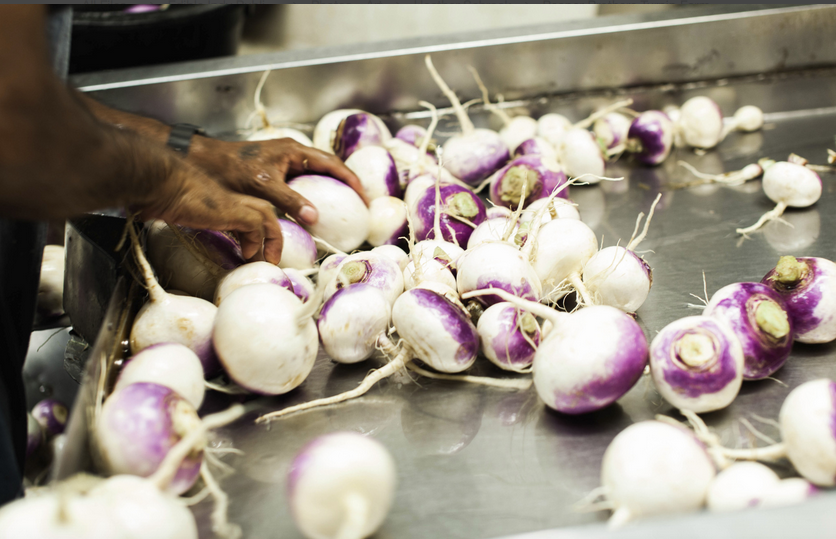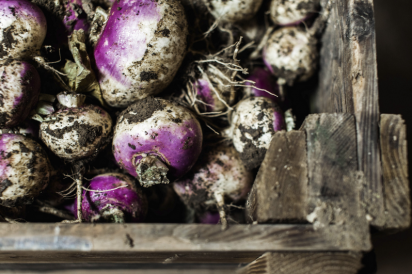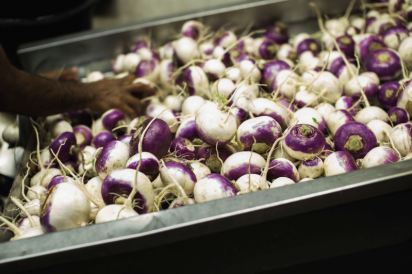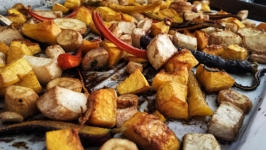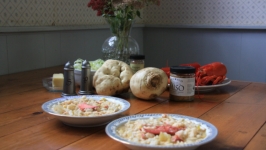Turnip Awareness: Peaper Brothers Champions Humble Veggie for Five Generations
Take a bite into a Peaper Brothers turnip, and it’s all crunch and sweetness. I know, because Paul W. Peaper himself peeled back the purple skin of one the turnips grown on his family farm, sliced it into bite-sized pieces and handed one to me to try when I visited their farm recently.
“Ummm, it’s sweet,” I said, and Paul smiled. Because it was one thing for him to try to describe what makes the Peaper heirloom turnips different. It was another to see the look on my face, the look he sees over and over when people realize these are not their grandparents’ turnips.
The Peaper turnips are Paul’s grandparents’ turnips, though. The story of the Peaper Brothers farm begins nearly 150 years ago when William Pieper and Henrietta Wegherst emigrated from Germany to begin new lives in the United States. Though they came separately they met in Indianapolis, where they were later married on August 17, 1877.
William and Henrietta established a garden business on five or six acres on what is now known as Pleasant Run Boulevard. They, along with their sons, Fred and Chris, grew a variety of vegetables at that location until 1909, when they purchased 26 acres on Bluff Road and relocated the business. The current Peaper Brothers Farm continues in the Bluff Road location today, just four and a half miles south of downtown Indianapolis.
Under the leadership of Fred and Chris, the Peapers primarily grew hothouse vegetables—tomatoes and lettuces—and joined forces with other local vegetable growers to form the Marion County Greenhouse Growers Association. Together, they sold vegetables under the “Hoosier Boy” brand.
After the end of World War II, the third generation of Peapers took over the family business: Fred’s son, Herb, and Chris’ sons, Fred and Paul. Under the leadership of the new generation, the farm began to mass produce the purple-top turnips by implementing row cropping and root cellars and eventually expanding through the use of a new cold storage system and warehouse packing facility.
Eventually, health difficulties for Herb and Paul created the need for the fourth generation of Peapers to take over the farm, including Paul’s son, Paul W., and son-in-law, Ron Kocher. In 1987, Peaper Brothers was incorporated, and today, Mike Kocher, Ron’s son, has joined Paul W. as the fifth generation of Peapers to own and operate the business. Ron and his wife, Mary (Peaper) Kocher, also are still an active part of the day-to-day operations of Peaper Brothers.
In addition to the three full-time employees—Paul W., Mike, Mary and other family members who help out as needed—Peaper Brothers employs as many as 15–20 seasonal employees during the spring and fall to help with all aspects of their farm from planting to packing. Harvest season, especially the larger fall harvest, necessitates the most workers.
Once harvested, Peaper turnips can stay in cold storage for up to six months. Employees move the turnips straight from the field—where they are hand-harvested—to 20-bushel wooden crates in the refrigerated warehouse right on the farm with the dirt still clinging to the stubbled top and roots.
When Peaper Brothers gets an order from one of the wholesalers they work with—Midwest companies like Indianapolis Fruit, Castellini, Piazza Produce and Horton Fruit Company—they bring the turnips out of cold storage and into the washer. The turnips are then graded, bagged and stacked on pallets. Through the various wholesalers, Peapers’ products end up in groceries and restaurants as far away as New Jersey and Georgia, and as close as local Marsh and Meijer supermarkets in Indiana. Another 10,000 pounds of off-grade turnips are donated to Gleaners Food Bank, as well as the many more that are damaged or unable to be consumed by humans and are sold for pennies on the dollar to local cattle farmers.
“That’s the thing with farming: You never know what’s going to sell,” Paul W. said. “We put the turnips in cold storage, and they can stay there until February or maybe even as late as April. But the longer they’re in cold storage, the more you lose because of evaporation and shrinkage. The more we sell fresh, the better.”
When I asked him what’s changed over the years at Peaper Brothers, Paul W. shrugged and said, “Not much.” It’s true: Peaper Brothers has been known for their turnips since the middle of the 20th century, and turnips are still the mainstay of the business. They haven’t gone the way of farm markets or direct sales to restaurants or grocery retailers, either. The cold storage system and warehouse packing facility still operate mostly the same as when they were built, too.
But the hothouses are gone now, and instead of irrigation the Peapers use an eco-friendly raised-bed plastic covering with drip tape to water the roots of plants instead of the whole field. Also, the Peapers don’t rely on turnips as much as they used to. Part of that is the Peapers’ desire to grow a greater variety of crops to meet the ever-changing needs of the consumer: peppers, kale, cabbage and winter squashes. The other part, though, is the declining popularity, or even familiarity, with the turnip.
“When I tell people we grow turnips, I usually get three responses,” Mike told me during my visit. “Either ‘What’s a turnip?’ or ‘I’ve never eaten a turnip’” or “‘Oh yeah, I’ve had a turnip; my grandma used to make them.’”
For that reason, “turnip awareness” is one of Mike’s business development priorities, including taking cut-up raw turnips, his favorite way to eat them, to his daughters’ school, and even teaming up with Lori Taylor, The Produce Mom, to talk about the purple root vegetable most people think they don’t like.
According to Paul, the distaste may be because of the way it was cooked—“most people remember them as mushy and maybe bitter”—or the way it was grown. Peaper turnips are grown and harvested only in the spring or fall. With a 50- to 60-day growing season, the vegetables are planted either in March or August, and harvested no later than June or November, before the heat or cold can change their taste or composition. Indiana weather, along with the rich Hoosier soil, means turnips grown elsewhere might not taste like a Peaper.
“The tastes gets what I call pithier, or hotter, in other climates,” Paul said. “Ours are sweet and moist. It’s one of our tricks of the trade.”
In the future, Mike envisions raw turnips being sold in individual snack packs or as part of a veggie tray, though the logistics to make that happen as part of their own operations are not feasible at this time.
“Selling whole is different than selling sliced or processed,” Mike said. “There are more hoops to jump through with the USDA and food safety rules.”
For now, the Peapers carry on with their planting and harvesting. They continue to look for more wholesale distributors to partner with. And they hope for continued success of the Peaper turnips and all their produce so they can pass along a productive and vibrant operation to the sixth generation of Peapers when that day comes.


